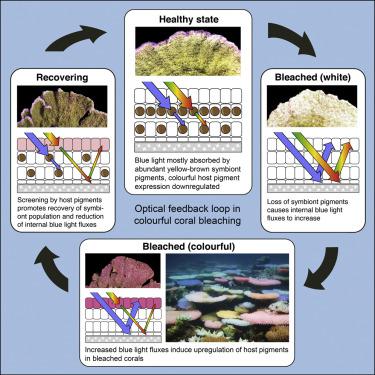Current Biology ( IF 9.2 ) Pub Date : 2020-05-21 , DOI: 10.1016/j.cub.2020.04.055 Elena Bollati 1 , Cecilia D'Angelo 2 , Rachel Alderdice 3 , Morgan Pratchett 4 , Maren Ziegler 5 , Jörg Wiedenmann 2

|
Coral bleaching, caused by the loss of brownish-colored dinoflagellate photosymbionts from the host tissue of reef-building corals, is a major threat to reef survival. Occasionally, bleached corals become exceptionally colorful rather than white. These colors derive from photoprotective green fluorescent protein (GFP)-like pigments produced by the coral host. There is currently no consensus regarding what causes colorful bleaching events and what the consequences for the corals are. Here, we document that colorful bleaching events are a recurring phenomenon in reef regions around the globe. Our analysis of temperature conditions associated with colorful bleaching events suggests that corals develop extreme coloration within 2 to 3 weeks after exposure to mild or temporary heat stress. We demonstrate that the increase of light fluxes in symbiont-depleted tissue promoted by reflection of the incident light from the coral skeleton induces strong expression of the photoprotective coral host pigments. We describe an optical feedback loop involving both partners of the association, discussing that the mitigation of light stress offered by host pigments could facilitate recolonization of bleached tissue by symbionts. Our data indicate that colorful bleaching has the potential to identify local environmental factors, such as nutrient stress, that can exacerbate the impact of elevated temperatures on corals, to indicate the severity of heat stress experienced by corals and to gauge their post-stress recovery potential.
Video Abstract
Download : Download video (160MB)
中文翻译:

涉及甲藻共生体和巩膜菌宿主的光反馈回路驱动彩色珊瑚漂白。
珊瑚白化是由造礁珊瑚宿主组织中褐色甲藻光共生体的丧失引起的,是对珊瑚礁生存的主要威胁。有时,漂白的珊瑚会变得异常多彩而不是白色。这些颜色来自珊瑚宿主产生的光保护性绿色荧光蛋白 (GFP) 样色素。目前还没有就导致彩色白化事件的原因以及对珊瑚造成的后果达成共识。在这里,我们记录了五颜六色的白化事件是全球珊瑚礁地区反复出现的现象。我们对与彩色漂白事件相关的温度条件的分析表明,珊瑚在暴露于轻度或暂时的热应激后 2 到 3 周内会出现极端着色。我们证明,通过来自珊瑚骨架的入射光的反射促进共生体耗尽组织中光通量的增加诱导光保护珊瑚宿主色素的强烈表达。我们描述了一个涉及协会双方合作伙伴的光学反馈回路,讨论了减轻宿主色素提供的光应力可以促进共生体对漂白组织的重新定植。我们的数据表明,彩色漂白有可能确定局部环境因素,例如营养压力,这些因素会加剧高温对珊瑚的影响,表明珊瑚所经历的热应激的严重程度,并衡量它们的压力后恢复潜力.
视频摘要
下载 :下载视频 (160MB)


























 京公网安备 11010802027423号
京公网安备 11010802027423号